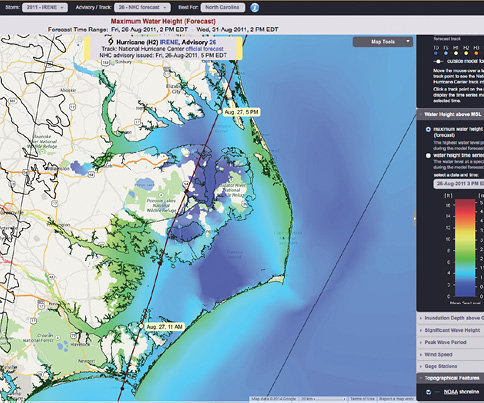
RENCI’s Hatteras HPC cluster depends on Dell technologies for high-resolution storm surge and hurricane wind wave predictions. Image: RENCI
Latest News
May 24, 2017
 When hurricanes bear down on the coast of North Carolina, it is essential that storm surge forecasters at the National Hurricane Center in Miami, FL—and local and regional emergency managers—have as much high-fidelity information as possible. Their forecast guides storm surge predictions and warnings used to inform the public about potentially hazardous water levels and wave heights.
When hurricanes bear down on the coast of North Carolina, it is essential that storm surge forecasters at the National Hurricane Center in Miami, FL—and local and regional emergency managers—have as much high-fidelity information as possible. Their forecast guides storm surge predictions and warnings used to inform the public about potentially hazardous water levels and wave heights.
 RENCI’s Hatteras HPC cluster depends on Dell technologies for high-resolution storm surge and hurricane wind wave predictions. Image: RENCI
RENCI’s Hatteras HPC cluster depends on Dell technologies for high-resolution storm surge and hurricane wind wave predictions. Image: RENCIGetting the most detailed storm surge information and data to forecasters is one of the goals of the Renaissance Computing Institute (RENCI). Part of the University of North Carolina at Chapel Hill, RENCI is a collaborative effort between UNC–Chapel Hill, Duke University and North Carolina State University. The institute, which uses high performance computing (HPC) to develop and deploy advanced technologies, focuses on providing computations such as storm surge data to customers including the National Hurricane Center and FEMA.
Growing Needs for High-Resolution Data
Perhaps the biggest challenge for RENCI is getting storm surge data to customers as quickly as possible. For example, the typical forecast cycle is six hours long, meaning that federal forecasting operational centers publish their meteorological forecasts every six hours. To be effective and relevant, RENCI’s storm surge prediction system needs to complete its analysis as soon as possible after the official forecast time. Coarse storm surge models run in minutes, but RENCI’s modeling system resolves small but important details of the coastal region, and hence takes longer to complete.
Learn how RENCI created a new HPC cluster called Hatteras that is based on Dell PowerEdge M1000e blade enclosures and PowerEdge M420 blade servers to create more complete storm surge modeling in a shorter time frame.
Subscribe to our FREE magazine, FREE email newsletters or both!
Latest News






